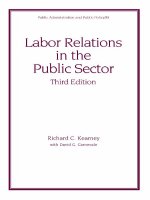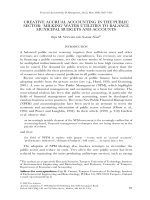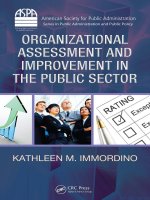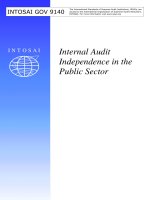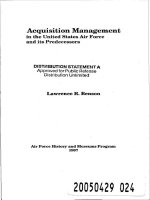Financial management in the public sector tools, applications, and cases
Bạn đang xem bản rút gọn của tài liệu. Xem và tải ngay bản đầy đủ của tài liệu tại đây (10.87 MB, 218 trang )
Financial Management
in the Public Sector
Financial Management
in the Public Sector
Tools, Applications, and Cases
XiaoHu Wang
M.E.Sharpe
Armonk, New York
London, England
Copyright © 2006 by M.E. Sharpe, Inc.
All rights reserved. No part of this book may be reproduced in any form
without written permission from the publisher, M.E. Sharpe, Inc.,
80 Business Park Drive, Armonk, New York 10504.
Screen shots reprinted by
permission from Microsoft Corporation.
Library of Congress Cataloging-in-Publication Data
Wang, XiaoHu, 1962Financial management in the public sector : tools, applications, and cases
/ by XiaoHu Wang.
p. cm.
Includes bibliographical references and index.
ISBN 0-7656-1677-7 (cloth : alk. paper)
1. Finance, Public. 2. Finance, Public—Accounting. 3. Budget. I. Title.
HJ141.W36 2006
352.4—dc22
2005024995
Printed in the United States of America
The paper used in this publication meets the minimum requirements of
American National Standard for Information Sciences
Permanence of Paper for Printed Library Materials,
ANSI Z 39.48-1984.
~
BM (c)
10
9
8
7
6
5
4
3
2
1
For my wife, Yan
Contents
List of Illustrations
Preface and Acknowledgments
xiii
xvii
Part I. Tools for Financial Planning
1. Revenue Forecasting
Learning Objectives
Concepts and the Tool
Simple Moving Average (SMA)
Exponential Smoothing (EXS)
Transformation Moving Average (TMA)
Regression Against Time (Regression)
A Quasi-Causal Forecasting Model
Determining Forecast Accuracy
A Case Study
Step 1: Cleaning the Data
Step 2: Choosing the Forecasting Technique
Step 3: Forecasting
Step 4: Monitoring Forecasting Performance
Exercises
3
3
4
4
5
8
9
10
11
13
14
15
16
16
17
2. Resource Development Analysis
Learning Objectives
Concepts and the Tool
Defining the Issue: Revenue Shortage
Estimating Revenue Shortage
Developing Revenue Options
Assessing Revenue Options
Making Decisions
21
21
21
22
23
27
30
32
vii
viii
CONTENTS
A Case Study
Step 1: Defining the Issue
Step 2: Estimating Revenue Shortage
Step 3: Developing Revenue Options
Step 4: Assessing Revenue Options
Step 5: Making Decisions
Exercises
32
34
34
37
38
39
39
3. Cost Estimation
Learning Objectives
Concepts and the Tool
Cost Classification
Total Cost Estimation
Average Cost Estimation
A Case Study
Step 1: Determination of Personnel Costs
Step 2: Determination of Operating Costs
Step 3: Determination of Capital Costs
Step 4: Determination of Total Program Cost
Step 5: Determination of Average Cost
Exercises
42
42
43
43
45
48
48
49
49
50
51
52
52
4. Cost Comparison
Learning Objectives
Concepts and the Tool
A Case Study
Step 1: Estimation of Project Costs
Step 2: Determination of Present Value of Cost (PVC)
Step 3: Making Decisions
Exercises
55
55
55
59
59
59
61
61
5. Incremental Cost Analysis
Learning Objectives
Concepts and the Tool
A Case Study
Step 1: Examining Each Cost Item
63
63
64
66
67
CONTENTS ix
Step 2: Determining Incremental Cost (or Marginal Cost,
If Necessary)
Step 3: Making Decisions
Exercises
6. Cost-Benefit Analysis
Learning Objectives
Concepts and the Tool
Introduction to Cost-Benefit Analysis
Issues in Cost-Benefit Analysis
A Case Study
Step 1: Formulating the Question in Cost-Benefit Analysis
Step 2: Determining the Benefit
Step 3: Determining the Cost
Step 4: Determining the Discount Rate
Step 5: Calculating the Net Present Value
Step 6: Making Decisions
Exercises
67
67
67
70
70
70
70
72
75
77
77
78
78
78
79
79
Part II. Tools for Financial Implementation
7. Financial Performance Monitoring
Learning Objectives
Concepts and the Tool
Determining Monitoring Indicators
Detecting Unacceptable Performance
Understanding the Causes and Taking Action
A Case Study
Step 1: Determining and Accessing Individual
Financial Indicators
Step 2: Detecting Unacceptable Performance
Step 3: Understanding Causes of Underperformance
Step 4: Developing a Monitoring Report
Exercises
85
85
86
86
90
92
94
94
95
95
96
96
8. Cash Management: Determining the Optimal Cash Balance
Learning Objectives
99
99
x
CONTENTS
Concepts and the Tool
Creating a Cash Budget
Determining the Optimal Cash Balance
A Case Study
Step 1: Data Collection and a Review of the Data
Step 2: Use of the Miller-Orr Model
Step 3: Conducting the Analysis
Step 4: Making Decisions
Exercises
100
100
102
106
106
107
108
108
109
Part III. Tools for Financial Reporting and Analysis
9. Financial Reporting and Analysis: The Statement of Net Assets
Learning Objectives
Concepts and the Tool
What Information Is in the Statement of Net Assets?
The Accounting Process
Principles that Govern Accounting Practices
A Case Study
Step 1: Reviewing and Analyzing this Year’s Statement
of Net Assets
Step 2: Comparing with Last Year’s Statement
Step 3: Searching for Solutions and Taking Actions
Exercises
10. Financial Reporting and Analysis: The Statement of Activities
Learning Objectives
Concepts and the Tool
What Information Is in the Statement of Activities?
Accounting Bases
A Case Study
Step 1: Examining the Statement of Activities
Step 2: Comparing with Last Year’s Statement
Step 3: Searching for Solutions and Taking Action
Exercises
115
115
116
116
118
121
122
123
123
125
126
128
128
128
129
133
134
134
134
135
136
CONTENTS xi
11. Financial Reporting and Analysis: Fund-Level Statements
Learning Objectives
Concepts and the Tool
Governmental Funds
Proprietary Funds
Fiduciary Funds
A Case Study
Step 1: Reviewing the Fund Statements
Step 2: Comparing with Last Year’s Statements
Step 3: Analyzing the Issues
Step 4: Searching for Solutions
Exercises
137
137
138
138
141
141
142
142
142
143
145
146
12. Financial Condition Analysis
Learning Objectives
Concepts and the Tool
What Is Financial Condition Analysis?
Determining Measures in FCA
Identifying Any Warning Trend of Deteriorating
Financial Condition
Specifying the Relationship
Explaining the Relationship
FCA Report Writing
A Case Study
Step 1: Defining the Scope of the Analysis
Step 2: Determining Measures and Collecting Data
Step 3: Identifying Warning Trends
Step 4: Specifying the Relationships
Step 5: Explaining the Relationships
Step 6: Taking Action to Improve Financial Condition
Exercises
148
148
148
148
150
Appendix: Exercise Answers
173
Index
187
153
155
157
158
158
159
160
162
163
165
167
168
xii
CONTENTS
List of Illustrations
Tables
1.1
1.2
1.3
1.4
1.5
1.6
1.7
1.8
1.9
1.10
1.11
1.12
2.1
2.2
2.3
2.4
2.5
2.6
2.7
2.8
2.9
2.10
2.11
3.1
Forecasting Example One
Forecasting Example Two
Incremental Changes in TMA
Franchise Taxes in City of Sunburn
Incremental Changes of Franchise Taxes in City
of Sunburn
Utility Taxes in Sunnytown, Florida
Comparison of MAPEs
Revenues of the Past Five Years
Licenses, Permits, and Fees in Sun Lake
Franchise Taxes in Sunbelt
Franchise Taxes from BellSouth in Sunbelt
Miscellaneous Revenues
Example of Estimating Expenditure Growth
Two Possible Spending Scenarios
Applicability of Revenue Options According to Activity Type
Applicability of Revenue Options According to Time Frame
The Decision-Making Matrix for Revenue Options
Estimated Expenditure Next Year in Woodbury
Expenditure Saving Estimate If Woodbury Leaves
Revenue Shortage Estimate If Woodbury Leaves
A Sales Tax Example
A User Charge Example
An Example of Expenditure Estimation
Cost Estimation for the Northenville COP Program
xiii
4
8
9
12
12
14
16
17
19
19
20
20
26
27
31
31
33
35
36
37
40
40
41
51
xiv
4.1
4.2
4.3
5.1
5.2
5.3
5.4
6.1
6.2
6.3
6.4
7.1
7.2
7.3
8.1
8.2
8.3
8.4
8.5
8.6
8.7
9.1
9.2
9.3
10.1
10.2
10.3
LIST OF ILLUSTRATIONS
Estimated Cost of the Maintenance Option
Estimated Cost of a New Swimming Pool
Cost Estimates for EOP and PMS
Incremental Cost Analysis
Incremental Cost Analysis (Continued)
Cost Comparison in Incremental Cost Analysis
Incremental Costing Exercise
CBA for Garbage Pickup Options
Present Value of Benefits for QTS
Present Value of Costs for QTS
Cost-Benefit Analysis for Two Public Infrastructure Projects
Operating Surplus (or Deficit) of the Past Three Years
Revenues, Expenditures, and Surplus (Deficit) in the
Current Year
Expenditure by Function
Expected Cash Receipts by Source in January
Expected Cash Disbursements by Function in January
Cash Budget
An Example of Computing Variance of Daily Net
Cash Flow
Cash Flows and Balances of Riverside
Cash Flows of Selected Days
Monthly Cash Flows: Bridgetown Foundation
Statement of Net Assets: The City of Evergreen, Florida,
for the year ending December 31, 2004
Asset and Liability Allocations: The City of Evergreen,
Florida, as of December 31, 2004
Statement of Net Assets Comparison: The City
of Evergreen
Expenses in the Statement of Activities: The City
of Evergreen, Florida, for the year ending December 31, 2004
Expenses, Program Revenues, and Net (Expenses) Revenues
in the Statement of Activities: The City of Evergreen, Florida,
for the year ending December 31, 2004
Expenses, Program Revenues, Net (Expenses) Revenues, and
General Revenues in the Statement of Activities: The City of
Evergreen, Florida, for the year ending December 31, 2004
60
60
62
65
66
68
69
72
78
78
80
92
93
93
100
101
101
104
107
110
110
119
124
125
130
131
132
LIST OF ILLUSTRATIONS
Comparison of Net (Expenses) Revenues and General
Revenues: The City of Evergreen, Florida, for the year
ending December 31, 2004
11.1 Balance Sheet of the General Fund, December 31, 2004:
The City of Evergreen
11.2 The Statement of Revenues, Expenditures, and Changes
in Fund Balance, the General Fund, December 31, 2004:
The City of Evergreen
11.3 The General Fund Revenues and Expenditures in 2004:
The City of Evergreen
11.4 The Revenue and Expenditure Comparison:
The General Fund in the City of Evergreen
11.5 The Millage of Local Real Property Taxes for Citywide
Services: The City of Evergreen
12.1 Socioeconomic/Organizational Factors in FCA
12.2 Population and Revenues
12.3 Interpretation of the Correlation Coefficient
12.4 Population, Revenues, and Revenue Per Capita
12.5 CAFR Data for the City of Lucille
12.6 Operating Ratio and Own-Source Revenue Ratio
12.7 What May Affect the Operating Ratio?
12.8 What May Affect Revenues?
12.9 What May Affect the Own-Source Ratio?
12.10 Expenditure Data
12.11 City of Lucille’s Additional Financial Data for the
Past Five Years
xv
10.4
135
140
140
143
144
145
154
155
157
158
161
162
163
164
164
169
170
Figures
6.1
6.2
8.1
9.1
9.2
9.3
12.1
VTM Diagnostic Process
QTS Diagnosis
The Miller-Orr Model
Example of an Accounting Journal
Example of an Accounting Ledger
The Accounting Equation with a Transaction
The Impact of Assessed Values on Budget Solvency
76
77
103
120
121
122
165
xvi
12.2
12.3
LIST OF ILLUSTRATIONS
The Impact of Population on Budget Solvency
The Impact of the Millage on Budget Solvency
166
167
Excel Screens
1.1
1.2
1.3
4.1
4.2
8.1
12.1
Simple Moving Average
Exponential Smoothing
Regression Against Time
Calculating Present Value
Calculating Annualized Cost
Calculating Variance of Net Cash Flow
Calculating Correlation Coefficients
6
7
10
57
58
105
156
Preface and Acknowledgments
I always ask a few questions before buying a book. What is the book about?
Why did the author write it? How are important topics covered? I use this
preface to answer some questions that may be in the mind of a possible reader.
Why Did I Write this Book?
I wrote this book because I want the reader to use it, not just read it. This is a
book about application. It is about using what is learned. During my decadelong teaching experience on financial management and budgeting, I have
learned that two things really stimulate student learning. One is an instructor’s
interest in student learning. Another, more important factor, is application of
the materials. If students know they will use what they learn, they are more
interested in learning it. This book emphasizes the application of budgeting
and financial management tools in the real world. Its goal is to familiarize
students with the application of analytical tools to resolve financial management and budgeting issues.
How Are Applications Emphasized in this Book?
The book uses a case study approach to illustrate the application of financial
management and budgeting concepts and tools. Each chapter starts with a
discussion of a tool (or tools) and related concepts, with examples. It then
presents a factual case study to demonstrate the use of the tool(s). The chapter ends with a list of exercise questions. This presentation method is the
result of my longtime experience teaching analytical techniques, which often require repetitive examples, cases, and exercises for student learning and
application. This method stresses the importance of the case study. The case
study allows students to understand the conditions under which a tool can be
properly used. It also stimulates student interest and learning by relating the
tools to a real-world scenario. Each case study here presents a step-by-step
guide to application. A case starts with a presentation of a decision-making
xvii
xviii
PREFACE AND ACKNOWLEDGMENTS
scenario in which a tool can be applied, and then demonstrates its application in solving the problem, step by step. The exercises reinforce student
understanding of the tools. Exercises also allow students to experience possible variations of a tool.
Microsoft® Excel spreadsheet software is used as an example in assisting students in financial calculation. Financial calculation is a critical part of
budgeting and financial management, but is often ignored by textbooks. Since
the processes of many calculations are complex, the use of computer software or financial calculators is necessary. Excel is a popular and powerful
software program for financial calculation. This book provides step-by-step
examples of Excel programming for many tools. The use of Excel can save
students time in calculating and enables the instructor to teach calculationsophisticated tools that they couldn’t teach otherwise.
What Is Covered in this Book?
The material is covered in three sections: financial planning, financial implementation, and financial reporting and analysis. In the financial planning
section, the focus is on how to project and develop financial resources (Chapter
1: Revenue Forecasting; Chapter 2: Resource Development Analysis), and
on how to plan and improve resource use (Chapter 3: Cost Estimation; Chapter 4: Cost Comparison; Chapter 5: Incremental Cost Analysis; Chapter 6:
Cost-Benefit Analysis).
The focus in the financial implementation section is on tools to detect and
correct undesirable financial operations, and on tools to ensure continuation
of normal financial activities (Chapter 7: Financial Performance Monitoring). Tools to monitor cash flows are also covered in this section (Chapter 8:
Cash Management: Determining the Optimal Cash Balance).
In the financial reporting and analysis section, the material stresses how
to use financial information to analyze and improve the financial condition
of an organization. This section highlights the two most important financial
reports in state and local governments: The Statement of Net Assets (Chapter
9) and The Statement of Activities (Chapter 10). It also presents financial
reporting at the fund level (Chapter 11). The last chapter discusses the tool to
evaluate the financial condition of a government (Chapter 12).
What Were the Criteria for Selecting Topics to Cover?
First, a topic must be important in public financial management and budgeting. Financial managers are frequently asked to forecast revenues, evaluate
revenue potentials, compare and evaluate costs, monitor financial performance,
PREFACE AND ACKNOWLEDGMENTS
xix
manage cash flows, and conduct financial analysis. These topics are included
in the book. Second, a topic must be analytical in nature, which means that a
technical solution is needed and financial calculation is involved. Therefore,
simple subjects such as drafting a budget request, determining budget lineitem classifications, or preparing a spreadsheet of revenue (or expense) summary are not included.
Although the book does not provide comprehensive coverage of all tools
in public budgeting and finance, the analytical processes covered in the book
should be generic enough that the reader can relate and develop a good knowledge on analytical tools used in public budgeting and financial management.
Who Should Use the Book?
The book can be used as a supplementary textbook in a public budgeting or
a public financial management course. It can supplement a textbook that
mainly covers theories. It can also be used as a main textbook for a public
financial management course that focuses on application of budgeting and
financial management tools. Teachers of analytical techniques courses can
also consider it as recommended reading. Finally, it can be used by financial
and budget personnel in governments, or anyone who is interested in governmental finance.
What Is the Math Requirement for the Reader?
As the calculations can be performed using Excel, the math requirement for
the reader is minimal. A reader can readily understand the materials and
exercises with a basic knowledge of high school algebra.
Acknowledgments
I am very grateful to many people for their support, encouragement, and
suggestions. First, I want to thank the people I worked with at M.E. Sharpe
for their support: Harry Briggs, Elizabeth Granda, and Jennifer Morettini. I
thank my previous and current colleagues at the University of Central Florida
for their support and encouragement. I especially thank Lynda M. Dennis,
who read through a draft of this book and provided many valuable suggestions. I also thank the students in my financial management courses for their
feedback, and Jeff Tu for providing research assistance. Finally, special thanks
are reserved for my wife, Yan, whose love and support are an everlasting
source of inspiration for me.
xx
PREFACE AND ACKNOWLEDGMENTS
REVENUE FORECASTING
PART I
TOOLS FOR FINANCIAL PLANNING
1
CHAPTER 1
Revenue Forecasting
Learning Objectives
After studying this chapter, you should be able to
• Use forecasting tools presented in this chapter
• Determine forecast accuracy
• Apply the most accurate tool for forecasting
Why forecast revenue? Revenue forecasting helps financial planning. Because revenue determines service capacity, accurate revenue forecasting allows for a good understanding of an organization’s ability to provide services.
Forecasting is also a process through which managers learn about their communities and organizations. For example, how much of a community’s resources
can be used to provide services in demand? How capable is the organization of
collecting these resources? A poor forecast—a large gap between the forecast
and actual revenues—warrants a close look at a community’s resource potentials and an organization’s revenue collection efforts.
Who does forecasting? It is often the responsibility of budget offices or
central management offices. Sometimes, individual agencies that have their
own resources, such as businesslike enterprise functions in many governments, also forecast their revenues.
What forecasting tools are available? A variety of qualitative and quantitative tools are used in revenue forecasting. The Delphi technique is perhaps
the most popular qualitative tool. It is a process in which a group of experts
are individually questioned about their perceptions of future events that will
affect the revenue flows. Each expert gives a forecasting figure and presents
a rationale, and then an outside party summarizes these forecasts and rationales and comes back to the experts with more questions. The process continues until a collective forecast is reached.
Quantitative forecast tools vary from simple smoothing techniques to
sophisticated causal modeling. It should be noted that mathematical
3
4
TOOLS FOR FINANCIAL PLANNING
Table 1.1
Forecasting Example One
Year
Revenues ($)
1
2
3
4
5
6
7
8
12.00
14.00
17.00
13.00
17.00
14.00
16.00
?
sophistication is not a guarantee of forecast accuracy. In this chapter we introduce quantitative tools that are simple to understand and easy and inexpensive to use. They are also the proper techniques for most revenue sources
in governments.
Concepts and the Tool
Before forecasting, several things need to be determined. First, the forecast
subject—what is being forecast—must be decided. Is a tax, a fee, or a user
charge being forecasted? Is the forecast for the whole organization/jurisdiction, or just a part of it? Second, a forecast horizon—the length of the forecast—must be established. Should revenue be projected for the next month,
the next year, or the next five years?
Third, the forecaster must become familiar with forecasting techniques in
order to select one that is proper for the forecasting need. This selection
involves a comparison of the forecast accuracies of different techniques in
order to choose the most accurate one. In this chapter, we study several forecasting techniques that have proven effective, simple to understand, and inexpensive to apply. They are simple moving average (SMA), exponential
smoothing (EXS), transformation moving average (TMA), regression against
time, and a quasi-causal technique. We can use Microsoft® Excel™ spreadsheet software to help us in these calculations. Excel is a spreadsheet program that can be used to perform quantitative and financial calculations. It is
very popular and easy to use. If you are not comfortable with it, take a look
at an introductory guide to the software. You should be ready in no time.
First, let us look at an example. The historical revenue information for a
hypothetical organization over the last seven years is shown in Table 1.1.
Using this information, forecast the revenue of the eighth year.
Simple Moving Average (SMA)
Using the simple moving average (SMA) technique, we calculate the arithmetic average of revenues in previous forecast periods (“years” in this case)
and use it as the forecast. To do so, we need first to determine the number of


